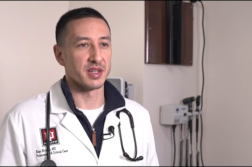CLEVELAND, Ohio (Ivanhoe Newswire) —Imagine your lungs slowly hardening and shutting down. It’s difficult to breath or even walk. That’s what more than 200,000 people will begin to experience this year. It’s call interstitial lung disease. There’s been very little to help patients, until now. A new drug is helping people breathe easier and live longer.
Bob Rawlins’ happiness is contagious.
He spreads hope volunteering at the local hospital every week.
Rawlins shared with Ivanhoe, “When I walk into a patient’s room and they see a guy coming in on oxygen and they have oxygen, right away, there’s a connection, right?”
Bob didn’t always need oxygen. Four years ago, the room started spinning, he had trouble walking, then…
“My kidneys were starting to fail,” Rawlins explained.
His family was preparing for the worst.
“My wife got down on her knees and grabbed my hand and she said she started to pray and then the two aides, the two nurses, and the two doctors that were there turned around and said, ‘We’d like to pray with you.’ So, that was one of those amazing things. So, it was pretty cool,” Rawlins recalled.
Bob was diagnosed with interstitial lung disease.
Kristen Highland, MD, the Director of the Rheumatic Lung Disease Program in the pulmonary department of the Respiratory Institute at Cleveland Clinic elaborated for Ivanhoe, “His lung disease is chronic, and he has very fibrotic changes on his chest.”
Cleveland Clinic pulmonologist Kristen Highland tried a new FDA approved drug, nintedanib to stop the progression. A recent study found there was a 57% reduction in the rate of lung function decline. Bob takes pills twice a day, along with weekly pulmonary therapy. It keeps him doing what he loves best.
“My nurses always nickname me ‘walkie talkie’, because I could walk, and obviously I talked too much,” Rawlins shared
As far as side effects, most patients report they experience increased reflux and diarrhea. This drug is also the first FDA approved therapy for scleroderma-associated interstitial lung disease.
Contributors to this news report include: Cyndy McGrath, Executive Producer; Marsha Lewis, Field Producer; Kirk Manson, Videographer; Roque Correa, Editor.
To receive a free weekly e-mail on Medical Breakthroughs from Ivanhoe, sign up at: http://www.ivanhoe.com/ftk
MEDICAL BREAKTHROUGHS
RESEARCH SUMMARY
TOPIC: SAVING LUNGS SAVING LIVES
REPORT: MB #4743
BACKGROUND: Interstitial lung disease or pulmonary fibrosis is the inflammation of the tissue that surrounds the lungs, blood vessels, and airways. This inflammation or scarring can inhibit breathing causing shortness of breath and coughing. While there is no cure for this disease, there are many treatments effective at slowing it down including medication, oxygen therapy, pulmonary and exercise therapy, and in extreme cases, a lung transplant. There is no known way to prevent idiopathic or genetic interstitial lung disease, but other types of the disease can be prevented by not smoking, wearing a respirator around harsh chemicals, and receiving immunizations for flu and pneumonia to protect the lungs.
(Source: https://my.clevelandclinic.org/health/diseases/17809-interstitial-lung-disease )
SCLERODERMA: Scleroderma is an uncommon but painfully chronic autoimmune disease found most often in women age 35 to 55. Why it is contracted is still unknown, it sometimes has genetic markers, but not often and it is not known to be contagious. The disease causes normal tissue to be replaced with dense, thick fibrous tissue and the patient’s immune system to generate too much collagen that gets deposited in the skin and organs. While it most commonly affects the skin, it can also spread to major internal organs and this is its most threatening feature.
(Source: https://my.clevelandclinic.org/health/diseases/8979-scleroderma-an-overview )
DIAGNOSIS: To be diagnosed with scleroderma the doctor must go through a full family medical history, perform a thorough physical exam and then run several tests. These include blood tests to look for elevated levels of immune factors such as antinuclear antibodies. Pulmonary function tests to measure how well the lungs are functioning or an x-ray or CT scan might also be used to check for lung damage. Gastrointestinal tests can determine if the scleroderma has affected the esophagus. Interstitial lung disease is diagnosed in many ways as well including physical exam, lung function test, imaging such as x-ray and CT, bronchoscopy in which the doctor inserts a camera through the nose or mouth to look at the lungs, or even in some cases a lung biopsy.
(Source: https://my.clevelandclinic.org/health/diseases/8979-scleroderma-an-overview/diagnosis-and-tests https://my.clevelandclinic.org/health/diseases/17809-interstitial-lung-disease/diagnosis-and-tests )
FOR MORE INFORMATION ON THIS REPORT, PLEASE CONTACT:
ANDREA PACETTI
(216) 316-3040
If this story or any other Ivanhoe story has impacted your life or prompted you or someone you know to seek or change treatments, please let us know by contacting Marjorie Bekaert Thomas at mthomas@ivanhoe.com




